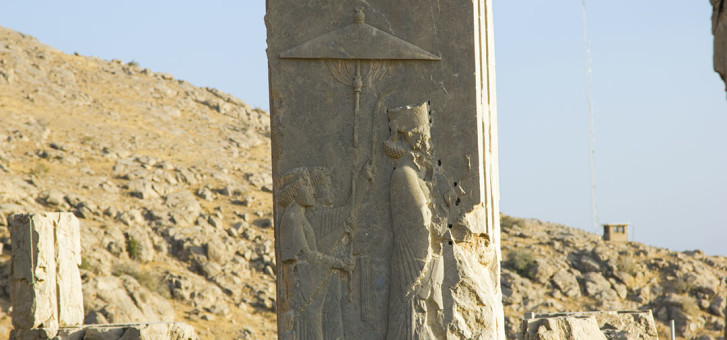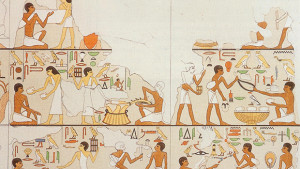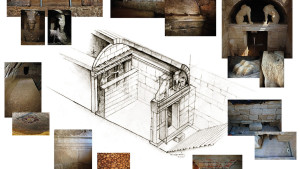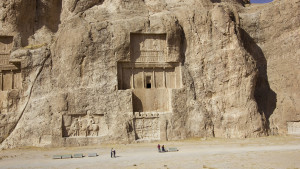While his death in 465 BC, Darius the Great's desire to see the subjugation of the Athenian state obviously remained unfulfilled. It was left to Xerxes the First, Darius’s son, to instigate a renewed attack against the Greek homeland. There are accounts, however, which suggest that the conquest of Greece was not foremost in his mind when Xerxes first ascended the throne. Indeed, his initial focus was on quelling insurrection, first at Babylon, as well as in Egypt. These matters would not be resolved until 485 bc.
Even so, a renewed attack on Greece was no certain thing. Xerxes shared much of his father’s astuteness and intelligence, qualities that informed him that there was little to be gained from another invasion of Greece. However, Mardonius, Commander in Chief of the Persian army, wanted the battle renewed; he was the primary agitator for a Greek campaign. There were, however, older and wiser heads, particularly Artabanus, Xerxes’ uncle and brother of Darius, who counselled strongly against such a venture, reminding Xerxes of his father’s catastrophic crusade.
Mardonius, however, directed Xerxes’ attention toward the paucity of the Greeks’ materiel resources and to the running sore, politically speaking, which was the perception of Athenian treachery (see previous article on Darius in November/December 2015 issue). Quoting Mardonius’s speech to Xerxes, Herodotus has him saying of the Greeks:
“It would indeed be a fearsome thing if we who have defeated and enslaved the Sacae, Indians, Ethiopians, Assyrians, and many other great nations who did us no injury, but merely to extend the boundaries of our empire, should fail now to punish the Greeks who have been guilty of injuring us without provocation. Have we anything to fear from them? The size of their army? Their wealth? The question is absurd; we know how they fight; we know how slender their resources are. People of their race we have already reduced to subjection—I mean the Greeks of Asia, Ionians, Aeolians, and Dorians. I myself have some experience of these men . . . . I got as far as Macedonia—indeed, almost to Athens itself—without a single soldier daring to oppose me.” (Herodotus, Histories 7.9)
In the end, the arguments of Mardonius prevailed. Yet along with the desire to exact retribution against the Athenians, it is quite possible that self-interest also entered the equation. Mardonius was supported by a group of exiled Greeks eager to see revenge wreaked upon their homeland and who possibly also saw a role for themselves in a future Greece under Persian rule. For his part, Mardonius saw himself becoming Satrap over the whole of Greece in the wake of victory.
For his protestation, Artabanus was accused of cowardice, and it was only the fact of his family ties to Xerxes that saved him from the consequences of his forthright opposition to the invasion. A subsequent (and convenient) vision enabled Artabanus to admit that he’d been wrong, and thus be readmitted into the king’s good graces.
Massive preparations
Still, the invasion was not a decision Xerxes took lightly; nor did he do things by halves. He knew from his father’s experience that any victory would only ever be hard won. He spent the next four years conscripting soldiers from the four corners of his kingdom, amassing supplies and producing armaments. By the end of the build-up he had assembled a huge army and massive fleet. While Herodotus’s figures of five million men and four thousand vessels are perhaps hyperbole, undoubtedly it could have been the largest military force ever to have marched into battle. Says Herodotus,
Some nations provided ships, others formed infantry units; from some cavalry was requisitioned, from others horse-transports and crews; from others, again, triremes for floating bridges, or provisions and naval craft of various kinds. (Herodotus 7.21)
By modern estimates, it was a force of one-third of a million warriors.
Xerxes obviously expected news of his vast army to reach the ears of the Greeks in Europe. The Asian territories through which he marched were, after all, home to many Greeks who had come under Persian jurisdiction and were capable of communicating with friends and relatives in their former homeland. Herodotus tells us that Xerxes’ first task upon reaching Sardis was to send representatives to every Greek city-state—except Athens and Sparta—demanding earth and water as a sign of their subservience to Persia, and to prepare entertainment for him when he arrived with his forces. Clearly he expected he would have little opposition from the cowed Greek cities that lay along his path to Athens.
To some extent this ploy was successful; when it came to the Greek resistance it was left to just 31 states, mainly in central and southern Greece, to meet and halt the invasion. Sparta, because it had the most effective military, was elected to lead the defence. The confederation also sought the assistance of Syracuse, the most powerful Greek city-state on Sicily; however they themselves were dealing with an attack from Carthage, in what may have been a campaign the Carthaginians had purposely coordinated with the Persian attack.
At Abydos, which today lies on the stretch of water we know today as the Dardanelles, where Anzac, French and British forces were to fight the Turks some 2500 years later, the Persians intended to cross the Hellespont from Asia to Europe by means of pontoon bridges. However, these were destroyed by a storm before they could be deployed. They were rebuilt, one with 360 triremes and penteconters (a smaller vessel) lashed together to form a new bridge, with another 314 vessels used to complete a second. Anchors were used to counter the winds that slammed the channel. Planks were laid over to form the thoroughfare, with brushwood overlaid. Soil was packed down to form a road surface. Paling fences lined both sides of the pontoon bridges to prevent horses and mules from taking fright.
Herodotus also records that many kilometres further north, Xerxes had a canal cut across the peninsular at Mt Athos in Northern Greece, across the Isthmus of Actium. It was a project three years in the making, the canal being some 2 km (1.5 miles) in length. With memories of the destruction wrought on the fleet when they last sailed around the peninsular, this canal was intended to give safe passage to the Persian vessels into the Aegean off the coast of Greece. For years, historians doubted that the canal had been completed, or even gotten past the earliest stages of construction, given the hard, rocky nature of the plateau where it was said to have been dug. Of more recent time, however, Herodotus’s account has been vindicated, as several metres below the surface geologists have detected something of a canal structure. Dr Ben Isserlin, an archaeologist from Leeds University, and Dr Richard Jones of Glasgow University, both have led work on the project, using seismic technology generally deployed for oil exploration. The canal’s width appears to span approximately 30 metres (100 ft), wide enough to accommodate two triremes side by side, with its banks sloped inwards as they reached a depth of 15 metres (50 ft).
After wintering in Sardis with his forces, Xerxes received the news that the canal at Mt Athos had been completed, so he marched to Abydos. An omen in the sky along the way predicted victory, cheering Xerxes’ spirits. The lead elements of his force carried the materiel on pack animals; these were followed by troops made up of a mix of nationalities. At around the mid-point of his column a thousand horsemen and an equal number of spearmen kept close attendance to King Xerxes himself. Ten large, sacred horses immediately preceded him, as did the chariot of Zeus drawn by eight horses, while the king’s chariot, drawn by the large Nisaean horses, followed that. Another thousand spearmen marched in his train, also with another thousand cavalry. These, in turn, were followed by 10,000 infantry and then, reputedly, 10,000 Persian horses. After a gap of two furlongs, the rest of his massed army marched.
Crossing the Hellespont
After the appropriate ceremonies, the crossing began. Herodotus tells us that they took a full week to transit from Asian to European soil. Once across, the fleet followed the coast to Cape Sarpedon while the army marched in concert. At the Persian garrison of Doriscus, he reorganised his troops and had his fleet brought ashore at an adjoining beach to dry out their planks. From this point, the army marched in detachments up the coast and across the top of the Aegean. The fleet followed the coast as well, and then was dispatched to sail through the Athos canal and to wait for the army in the sheltered waters of Therma (later known as Thessalonica).
At the outset, the Persian forces experienced little opposition. Many northern Greek city-states, as well as some in central Greece, quickly capitulated to the invading force. Their sparse and scattered populations made resistance futile in any case—and anyway, the Greeks remembered that the Persians had a reputation for treating their conquered peoples well. In addition, the Boeotian city-state of Thebes, which had long been at loggerheads with Athens and was located just 70 km (45 miles) north of the Athenian capital, supported the Persian advance in the hope of gaining both political and material advantage once a Persian victory was assured.
The stand of the “300”
Xerxes’ army took an inland route, which brought them to the coast at Thermopylae. This is where the Greeks would finally mount a resistance. Thermopylae, however, was only the second choice for the Greek defence. The first had been the Valley of Tempe to where a force of 10,000 hoplites had been dispatched, but from which were subsequently withdrawn when they realised the size of the Persian force and the vulnerability of their position. When the situation reached crisis point, it was determined that they would defend the pass at Thermopylae. The Greeks dispatched a force of 7000 warriors—the number being limited by the inevitable politicking between the city-states, as well as prevailing religious festivals, which curtailed military activities. But 300 of the defenders were the famed Spartans, the only professional Greek soldiers present and the ones soon to be etched with glory.
Some 150 km (95 miles) north of Athens, Thermopylae was a good place for the stand. It was a narrow, somewhat enclosed defile bordered by sea marshes to one side and sheer cliffs on the other, and surrounded by virtually unassailable mountains. The Greek forces under the leadership of Leonidas were the cork in the bottle, designed to prevent the Persian horde from advancing further. For four days the Persians were stalled, during which time Xerxes sent envoys asking the Greeks to lay down their arms to prevent bloodshed. Leonidas’s reply famously was, “Come and get them!”
After the failure of the initial attacks by Xerxes’ Median and Kissian forces, he dispatched his élite Immortals, who also failed to dislodge the Greeks. Close-quarter fighting was something at which the Greeks excelled and for which they were well-equipped (see previous article on the Battle of Marathon). The Greeks were also smart strategically, feigning a disorganised retreat before turning on their pursuers with a rehearsed tight phalanx formation that was virtually impenetrable.
On the second day, things went no better for the Persian forces—at least until a local Greek shepherd betrayed his countrymen by apprising the Persians of a track around the pass, so that they could attack from both the front and rear simultaneously. Phokian troops had been stationed at the pass to protect the Greek rear. However, these troops retreated to a defensive position when they saw the Persians advancing, so that the encircling forces were able to bypass and get behind the main Greek contingent below. When Leonidas saw that the whole of his force was threatened with annihilation, he ordered the bulk of his army to retreat, leaving 300 Spartans as a rear-guard, along with 700 Thespians and 400 Thebans, the latter held there much against their will.
On the third day, the Persian frontal attack was joined by the forces assembled at the Greek rear, as the king’s Immortals again entered the fray. The fighting was fierce. Leonidas was killed and his remaining force decimated by arrows, except the Thebans who may have surrendered. With the Greek heroes slain, Leonidas suffered the indignity of having his head impaled on a stake at the site of the battle. It was a barbarous act by Persian standards, perhaps spurred by the fact that two of Xerxes’ step-brothers fell before the victory was achieved.
First naval encounter
While all this was happening, off the coast of Artemisium, about 90 kilometres away, a fleet of Greek triremes were arrayed to intercept the Persian fleet should it attempt to sail down the sheltered coast of Boeotia. And just as Leonidas’s task was to stop the Persian army, the Greek fleet was to deny the Persian armada access to the straights of Euripus, which offered a sheltered passage of water in the lee of the island of Euboea. Around 270 Greek vessels under the admiralship of Themistocles had arrived at Artemisium to find the Persian fleet a scant 15 km (9.3 miles) away at Aphetae. The Persians had already lost a third of their triremes—not the most seaworthy of vessels—with heavy loss of life in a storm and accompanying heavy seas. But approximately 800 ships remained. With news of the Greeks’ arrival, the Persian admiral dispatched 200 triremes down the weather coast of Euboea to come up the narrows between the island and the mainland, so that the Persians could again attack from two directions.
The Greeks were forewarned of this strategy by a defector from the Persian ranks and prepared to meet the southern encircling force. When it failed to materialise they decided
to attack the main Persian contingent. The larger Persian fleet with their more agile ships encircled the Greeks, who formed a closed circle, their bows pointing outwards toward the foe. By the end of battle, in the coming dark, the Greeks had taken 30 Persian ships and some important captives. Both fleets retreated. The thunderstorm that came that night was a bad omen for the Persians, as was the sight of corpses and the detritus of battle which had washed towards their moorings, further unnerving the invaders. Then, unfortunately for the Persians, those vessels dispatched to circle Euboea had been driven onto rocks and sank in heavy seas.
The Persians were in recovery mode the following day: in no mood for another premature engagement. The Greeks, however, buoyed by the arrival of 53 triremes from Athens and news of the fate of the encircling Persian force, sailed out to destroy a small deployment of Persian vessels.
On the third day, the Persian fleet put to sea around midday, and approached the Greek fleet in a crescent formation meant to encircle their enemy. The press of ships meant that the oars of the Persian vessels fouled those of their neighbours, so forcing home their superior weight of numbers was difficult. The losses on both sides were heavy, and both fleets retreated again to lick their wounds. The Greeks then planned a strategic withdrawal, and did so without delay when news of the fate of Leonidas and his men reached them later that same day. The fleet sailed past Athens into the straights between Salamis and the mainland, the thinking being that the confined waters would make it again impossible for the Persian fleet to bring their superior strength to bear.
The Persians march
In the meantime Xerxes and his army took their leave of Thermopylae: the Persians hailed as victors as they marched, greeted by many of the local populace as friends (it was politic to do so). The main exception were the Phocians, a city-state that had sent troops to serve under Leonidas at Thermopylae. They were betrayed to the Persians by the Thessalians who acted as guides to help the invading force track down Greek loyalists. Phocian territory was overrun; their towns razed, many of their men cut down and the captured women were raped.
Fall of Athens
The Athenians had expected that the Peloponnesian armies would make a stand in Boeotia, inhabited by Greeks who sided with the Persians against the Athenians, to the north-west of their capital. Such a stand would provide, if nothing else, the opportunity for the Athenians to evacuate their women and children from their capital. In this they were to be sorely disappointed. The Peloponnesians had given up all hope of holding any of the main area of Greece and were now focused on defending their own territory, building a defensive line at the isthmus which linked the Peloponnesian territories with the rest of Greece, near where the Corinthian channel runs today. This meant that Athens could not be defended. However, rather than capitulate, the city of Athens was evacuated. As well as evacuating the women, children, the infirm and the old, so too the men of fighting age left, leaving no force to defend the city. The whole population streamed out of Athens—upwards of 50,000—and headed for the north-east Peloponnesian coast.
Finding Athens deserted, in an uncharacteristic violent action, Xerxes sacked Athens, setting it to the torch. It was an action he almost immediately regretted, yet it was a measure that showed the Persian antipathy towards Athens and exposed the full measure of the sense of betrayal that Xerxes felt on his father’s behalf, the perception of Athenian treachery of all those years before.
Engagement at Salamis
Just over a week later, the Greek fleet, anchored off the western coast of Attica, would be the key to Greek survival as a free homeland. The sacking of Athens may have steeled Athenian resolve, but their commander, the Athenian admiral Themistocles, was facing a crumbling resolve on the part of his Peloponnesian allies. These Greeks, perhaps quite reasonably, sought to retreat to their home territories taking with them their fleets to defend their homelands to the last. However, Themistocles saw the dangers of facing a numerically superior Persian fleet on the open sea. If the Greek fleet was spread out along the Peloponnesian coast in open waters, they could be devoured piecemeal. The unity of the Greek force was under such threat that Themistocles employed a brilliant deception. Before those elements of the Greek fleet that were wavering could break off and head out into open water, he dispatched an agent provocateur to the Persian forces to encourage them to close off the ends of the straights to prevent the disaffected Greek elements of the naval force from sailing away. The Persians obliged, not realising that they had played right into the enemy commander’s hands.
If the Greek forces were to prevail, they would have to adopt a similar tactic to the Spartans at Thermopylae, and indeed as had the fleet at Artemisium, to fight the Persian fleet in the confined waters between the mainland and the island of Salamis, where the Persians couldn’t bring the full force of their fleet to bear and where their superior manoeuvrability was compromised. There would be no room for anything but a grinding, close-quarter battle. Here the heavier Greek ships would bear down on the smaller Persian craft, their more massive forward underwater rams more effective at smashing the frailer, opposing vessels.
Athens had been building ships since 483 bc, for just such a time as this. Theirs was the largest contingent of the taskforce, its numbers expanded by Themistocles’ call for a fleet to protect the Athenian homeland from Persian designs. The bulk of the fleet were triremes, named for the three tiers of oarsmen, 170-strong, which propelled their vessels into battle. Usually ten hoplites with their spears, swords and shields, as well as four archers, occupied the upper deck preparatory to close-quarters battle. Officers and other crew added another 16 sailors to the complement. The Greek ships were large in comparison to the Persian vessels, yet they were cramped and without any accommodation for the crew. They were also unstable and were therefore pulled ashore at night to prevent them
getting into difficulties should the sea come up after the crew disembarked, explaining the ready loss of vessels during storms.
As sound as their battle plans may have been, the structure of the triremes meant that the crew were placed in a precarious position. Most oarsmen could not see out of the oar ports, so while the battle raged around them they had no appreciation, other than their own psychological fears, of what fate was about to befall them. In the heat of battle, it was not uncommon for the ranks below to suffer the indignities of the loosened bowels of the rowers above. So sound discipline was the key to success in such situations, something the Greeks possessed in abundance.
The Persians were beaten. Resoundingly. It is even possible that some of the Ionian ships in the Persian fleet held back from fully committing their forces because of the Greek heritage and secret sympathy they shared with their erstwhile homeland. The toll on the Persian forces was devastating. The crews of the sinking Persian ships, unable to swim, drowned. Greek survivors, however, were able to swim to friendly shores to fight again another day.
An inglorious retreat
Since Xerxes no longer had a fleet that could transport materiel to support his invasion, he retreated to Asia, his army living off the land as they passed, sometimes reduced to eating grass, bark and leaves when nothing else was available. Many of his troops suffered disease and dysentery, falling by the way, too sick to keep marching, many dying by the roadside. To add insult to injury, the bridges across the Hellespont had been destroyed by storms so they had to be laboriously ferried across by ship.
Mardonius’s fateful last campaign
However, Xerxes had left a vast land force in Greece—Herodotus put the number at 300,000—under General Mardonius, provisioned by the Greek states which supported the Persian campaign against Athens and the Peloponnesian states. The following year, in 479 bc, Xerxes offered Athens a peace treaty, but one which only applied to Athens, not the rest of the hostile city-states. He would even finance the rebuilding of Athens and give them new territories as recompense for what they had suffered at the hands of his army. On the face of it, the gesture was as magnanimous as the one his father had shown the Ionians in the wake of their rebellion all those years before. But it also heralded a bold strategy: with Athens as his ally, Xerxes could dominate the rest of Greece.
The Spartans, in particular, were alarmed by the implications of such a treaty on their security. In the end, however, the Athenians refused the offer. Perhaps they remembered the sacking of their city by the Persians. Perhaps they realised that once the rest of Greece had fallen into Persian hands they themselves would be isolated and fall under Persian dominion as well. Perhaps it was simply that they were Greek, and would not betray their own. Certainly, these were the mix of reasons for rejecting the Persian offer. If anything, the Athenians sought retribution for the destruction of Athens, not recompense, telling the unoccupied city-states, their allies:
"We all share the same ancestry and language; we have sanctuaries and sacrifices to the gods that we share, and we share a common way of life." (Herodotus, The Histories 8.144)
A second Athens Sacking
As a consequence, the Persian army marched into Attica to threaten Athens again. The city was evacuated and then destroyed a second time, and the surrounding countryside laid waste. The Spartans marched north to join the battle, not because of any altruistic impulses but because if they did not the Athenians threatened that they still could accept the offer of an alliance with the Persians!
The Greek and Persian forces met on the plains of Boeotia, just north of Athens. It would be the last great land battle of the era. The Persian force was, as always, overwhelming. The Spartans took the centre line and, again, the Greeks won a tremendous victory! Once the Persian leader Mardonius fell in battle, his forces were routed. It was called the Battle of Plataea. If this weren’t enough, the Greek fleet off Anatolia caught the Persian fleet unawares, disembarking to fight the Persians on shore and producing a rout of the Persian forces. This was the Battle of Mycale, and fought on the same day as the land battle in Europe. This one day, then, practically brought an end to Persian designs on Greek territory. Persia remained the great empire it was, but they had other concerns, including insurrections within their existing territories to attend to; they had no taste for more Greek determination or Greek steel.
Greek strength
There were a number of factors that contributed to the Greek dominance in their encounters with the Persians: superior tactics played a part, as well as superior weaponry and armour. There was also the “home-game” advantage, which enabled them to pick the most advantageous places to fight their battles. But what proved of most importance in the end, in spite of the disagreements and the vacillation on the part of some of the confederates, was that the coalition of 31 city-states held. And, as you might expect from a nation that would introduce democracy to the world, its people, of all ranks, joined in the common cause. It was a coalition of citizens which cut across all delineations of wealth or status to defeat a common enemy.
Xerxes’ end
Little is known of Xerxes’ final years. However, it appears that he withdrew further and further from public life, involving himself in, or perhaps defending himself from, internal palace intrigues. In 465 bc he was assassinated; the result of a plot by some of those ministers who were closest to the throne. Xerxes’ death was therefore more ignominious than his father’s; however, their respective Greek adventures cast the same shadow over their days. With the rule of Xerxes over, Artaxerxes I, Xerxes’ youngest son, ruled, but the Achaemenid Dynasty was approaching its end. Hostilities between the Achaemenians and Athens sputtered to an end by 448 bc during Artaxerxes’ rule; however these later conflicts never approached the scale of the first two campaigns and never again threatened the sovereignty of Greece.






